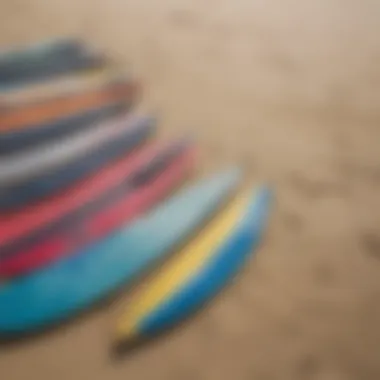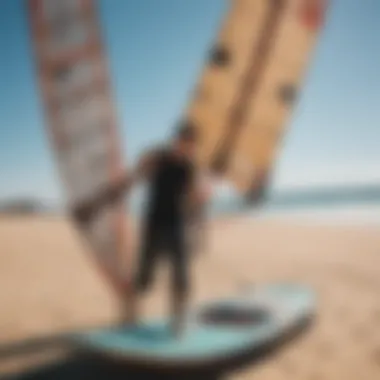Navigating the Used Kite Board Market Effectively


Intro
Diving into the world of used kiteboards can feel a bit like navigating a maze. With a myriad of options available and varying condition reports, even seasoned kiteboarding enthusiasts can find themselves second-guessing their decisions. The practice of buying second-hand equipment is not limited to financial efficiency; it's about discovering equipment that can provide you with thrilling experiences while also being kind to the environment. The gear you choose will significantly affect your time on the water, perhaps even influencing the skills you develop as a kiteboarder.
In this guide, we’ll slice through the jargon and complexities. We’ll take a good look at what makes a used kiteboard worthy of your time and money, while also navigating the environmental benefits tied to purchasing pre-owned gear.
Prepare to roll up your sleeves because maintaining this equipment can make a difference between a frustrating experience or one filled with joyous rides across the waves. Understanding your choices not only aids your performance but could also help you forge connections in the kiteboarding community. Let’s begin by examining the essential equipment insights.
Equipment Insights
Latest Gear Reviews
When it comes to the selection of used kiteboards, awareness of the latest gear trends can guide your decision-making process. It’s not about simply grabbing any board that catches your eye; instead, familiarity with the models that suit your riding style matters a great deal. Boards come in all shapes and sizes, and it’s crucial to sift through the options that align with your personal preferences and levels of expertise.
For instance, if you are looking for a board suitable for both flat water and choppy conditions, the Slingshot Terrain or North Kiteboarding's Frenzy might be up your alley. Neither of them is a wallflower; they provide a dynamic riding experience while being used. Examining online for rider reviews or checking forums can give you that extra insight, showing how different boards perform under various conditions and techniques.
Essential Gear Maintenance
Owning a used kiteboard comes with the responsibility of upkeep. To ensure your board lasts and performs well, here are a few tips:
- Regularly check the fins: Make sure they are not cracked and are firmly attached. Loose fins can ruin your day.
- Inspect the edges: The edges of the board are its lifeline. Avoid hitting rocks or hard surfaces as that can easily chip them.
- Clean the board: A simple rinse with fresh water after a session will help inhibit salt and sand accumulation, which can lead to wear and tear.
Remember: A well-maintained board can sometimes feel brand new, allowing you to ride with confidence. Taking those extra moments to check and clean your kiteboard may very well be the difference between an average session and a triumphant one.
"The secret to longevity in kiteboarding lies not just in the skill set but in the friendship you develop with your gear."
For many kiteboarders, the bond with their equipment speaks volumes about their experiences and adventures on the water. If you value your gear, it will return the favor.
Equipped with the right knowledge about gear, let’s transition into technique exploration. Kiteboarding is not just about the equipment; it’s also about how you ride.
Understanding Used Kite Boards
When one thinks about kiteboarding, the excitement of riding the waves on a breezy day usually comes to mind. However, the journey into choosing the right kite board, especially a used one, requires a deeper understanding. Knowing the ins and outs of used kite boards can empower both novice riders and seasoned kite surfers alike, allowing them to make educated choices.
Used kite boards offer not just a budget-friendly option but also a chance to dive into a diverse world of designs, shapes, and functionalities. Each board tells a story, and understanding them helps refine one's experience on the water. The act of selecting a used board ties directly into the very essence of kiteboarding—finesse, balance, and the thrill of experimentation.
Definition and Purpose
Used kite boards are essentially second-hand pieces of equipment that can range from nearly new to well-loved and seasoned by the elements. Much like picking out a vintage vinyl record, selecting a used board requires careful consideration of what suits both your style and skill level.
These boards serve several purposes. Initially designed for kiteboarding, they ultimately support the rider in their journey, enhancing skill development and overall enjoyment. They are critical in optimizing performance based on personal preferences, allowing for a tailored riding experience that new gear can’t always provide.
Drawn to the unique variations that each model presents, an enthusiast can find boards that whisper tales of adventure, while also being friendly to the wallet.
Market Demand for Used Equipment
Interestingly, the market for used kiteboarding equipment keeps growing, and there are reasons behind it. Many kiteboarders recognize that buying used equipment not only reduces costs but also lessens the carbon footprint associated with manufacturing new items.
As more riders embrace sustainability, demand has surged, transforming the used market into a treasure trove of opportunities. Sellers often find themselves in a competitive landscape, giving buyers an edge when it comes to price negotiation.
"Sustainability meets savings in the world of used kiteboards."
In addition, newcomers to the sport can test the waters without fully committing to hefty purchases. It’s often the case that a board appealing in the showroom doesn’t translate well to the water—buying used allows for trial and error without the hefty financial implications. This underscores the importance of understanding the dynamics of the used market, guiding riders to wiser purchases that resonate with their particular style and conditions.
Advantages of Choosing Used Kite Boards
When venturing into the realm of kiteboarding, the choice between new and second-hand equipment can significantly influence both your wallet and your overall experience. The advantages associated with selecting used kite boards are not just superficial considerations; they delve deeper into financial practicality and sustainability, creating a compelling case for engaging with pre-owned gear. The focus here is to illuminate the benefits, revealing how used kite boards can enhance your kiteboarding adventures while being kind to the environment.
Cost-Effectiveness
One of the most palpable benefits of choosing used kite boards is the cost-effectiveness associated with your selection. New kite boards can easily run into the range of several hundred to over a thousand dollars, particularly if you are eyeing high-performance models. In contrast, used boards often come at a fraction of that price. This allows novices and seasoned riders alike to invest in quality gear without breaking the bank.
Moreover, purchasing used kite boards opens up opportunities to try different styles and brands without draining your savings. For example, if you have your sights set on a renowned brand like Naish or Cabrinha, you might find previous models sold at prices that fit comfortably within your budget. This means you can experiment with various setups, evaluate what truly resonates with your riding style, and make informed decisions for future purchases.
Environmental Impact
In a world increasingly conscious of its environmental footprint, the decision to buy used kite boards resonates well with eco-friendly choices. The production of new kiteboarding equipment often involves extensive resources and energy, contributing to pollution and waste. By opting for second-hand equipment, you are not merely making an economical decision but also supporting a more sustainable cycle.
This choice prolongs the lifecycle of the equipment and reduces the demands on manufacturing, which is a noteworthy aspect that a lot of kiteboarders may overlook. Buying used gear means you contribute to reducing landfill waste and promote the principle of "reduce, reuse, recycle" in the kiteboarding community. You are, in essence, making a statement about valuing what already exists rather than fueling the machine of consumption.
Unique Finds and Vintage Models
Used gear often leads you down an exciting path of discovering unique finds and vintage models that might no longer be in production. Some kiteboard enthusiasts hold onto vintage boards because they offer distinct features or designs that newer models lack. There’s a certain charm in riding a classic piece of equipment, one that carries a story of adventures and challenges.
For instance, boards from manufacturers like Slingshot or F-One may showcase designs that modern counterparts have either omitted or altered drastically. The appeal of picking up a used board that has a character of its own cannot be understated.
Furthermore, within the world of second-hand equipment, one may stumble upon surf-style boards, or hybrid shapes that cater to specific riding styles. These finds provide riders with options not available in contemporary market offerings, allowing customization of the ride. Not only can this amplify your performance on the water, but it also reflects a personalized touch to your kiteboarding setup.
"Each used kite board has a story — one that can enhance your riding experience both on and off the water."


Evaluating Used Kite Boards
When it comes to used kite boards, knowing how to evaluate them is crucial. This aspect can make the difference between a rewarding experience on the water or a regrettable one. Buying second-hand gear can save you money, yet it also exposes you to risks if you're not savvy about what to look for. Evaluating used kite boards involves careful scrutiny to ensure that you get a good deal without compromising on safety or performance.
Physical Condition Analysis
Inspecting for Dings and Scratches
One of the first steps in evaluating a used kite board is checking for dings and scratches. These blemishes can significantly affect the board's performance. A ding might suggest that the board has suffered an impact potentially damaging its integrity. Scratches, while might appear harmless, can indicate wear and tear that could exacerbate over time.
The key characteristic to prioritize here is the overall condition of the board. If a board has numerous dings or deep scratches, you might want to think twice before buying it. It’s a beneficial choice for this article to emphasize thorough inspections, because these small cosmetic issues can lead to larger problems if ignored.
Unique to this inspection is the ability to assess whether the damage is superficial or a sign of deeper issues. Minor scratches can often be repaired easily, while significant dings may require professional maintenance or a complete board replacement, which adds to the overall costs.
Assessing the Integrity of Bindings
The bindings serve as the critical connection between the rider and the board. Assessing their integrity is another aspect that can't be overlooked. Make sure they are not frayed or cracked. Loose or broken bindings can lead to serious safety issues while riding.
What's beneficial about evaluating the bindings is that they significantly influence your comfort and performance while kiteboarding. If the bindings don't fit well or are showing wear, they might not hold you securely during your ride.
Moreover, the unique feature of this evaluation is that new bindings can be added or replaced, but at an additional cost. Therefore, if you find a board with faulty bindings, factor in the price of new bindings when negotiating.
Evaluating the Hull and Construction
The hull forms the backbone of the kite board. Evaluating the hull and its construction materials is essential in understanding the board’s responsiveness and durability on the water. Look for delamination or soft spots that might indicate structural compromise.
The attribute of construction quality matters, especially when considering boards designed for different environments and riding styles. The overall knowledge about construction methods can inform your purchasing decision and whether you opt for that specific used board.
Unique to this evaluation is the potential for performance variations among brands that utilize different materials. For instance, a board made of high-density foam core might offer better buoyancy but could be prone to damage compared to one that incorporates carbon fiber. Understanding the advantages and disadvantages of various hull constructions helps you make an informed choice.
Determining Board Specifications
When evaluating used kite boards, determining the specifications is pivotal. This information not only influences performance but also ensures that the selected board aligns with the user’s needs and skills.
Understanding Dimensions and Shape
The length, width, and shape of a kite board significantly affect its ride. Boards that are wider provide more stability, which can be beneficial for beginners learning the ropes. On the other hand, narrower boards might cater more effectively to experienced riders wanting agility and finesse.
The importance of understanding the dimensions lies in matching the board with your riding style. Each shape has its unique characteristics, making your choice about what feels right crucial.
Recognizing Volume and Weight
Alongside shape, paying attention to volume and weight can’t be overstated. Volume directly influences how a board floats and its ease of maneuverability. Lighter boards usually allow for easier tricks, while heavier options might offer more stability in choppy water.
Being aware of these factors assists in selecting a board that complements both the conditions of the water and your personal ability level. Understand that the balance between volume and weight can feel quite different depending on the rider; hence, it is important to test and find the right fit.
Matching Skill Level to Board Type
Lastly, a significant aspect of choosing a used kite board involves matching your skill level to the board type. Each board is designed with specific riders in mind. Beginners may benefit from boards that are more forgiving, whereas advanced kiteboarders may prefer boards that allow for speed and advanced trick execution.
Understanding this correlation is crucial; it greatly influences safety and enjoyment. Selecting a board that doesn’t align with your skill level not only hinders performance but could lead to frustrating experiences or even injuries.
Always remember, a board that matches your skill level empowers you to progress and enjoy your time on the water!
Where to Find Used Kite Boards
Finding the right used kite board can be as challenging as catching the perfect wind on a gusty day. It’s not just about getting any board; it’s about connecting with equipmentthat genuinely meets your needs while also offering access to unique finds. This section dives into various avenues where kiteboarders can locate second-hand boards, highlighting the strengths and weaknesses of each option.
Online Marketplaces
Specialized Kiteboarding Websites
When the internet became a part of our lives, it opened up a new world for enthusiasts. Specialized kiteboarding websites have sprung up as hubs for buying and selling used gear. What sets these platforms apart is their focus on kiteboarding, meaning they often feature listings tailored specifically for our niche. This synergy benefits sellers who want their posts seen by fellow kiteboarding aficionados and buyers seeking quality gear.
A standout feature of these websites is their ability to filter searches by specific brands, conditions, and price ranges. For instance, a site like Kiteboarding.com allows users to narrow down choices based on their experience level, ensuring a more tailored shopping experience. While dealing in a niche market can foster a sense of community, buyers should be aware that prices might run higher compared to other platforms, reflecting the quality and expertise behind these offerings.
General Online Classifieds
On the other hand, we have the general online classifieds, like Craigslist and Facebook Marketplace. Here, these platforms shine in their sheer volume of listings. The broader nature of these sites allows sellers from various backgrounds to list their gear, providing a wide array of options for buyers. This can lead to potential bargains if you’re willing to wade through listings and deal with varied seller practices.
A unique aspect of general classifieds is that you often can negotiate prices directly with sellers, giving you the flexibility to strike deals that specialized sites might not allow. However, this can also lead to drawbacks, such as inconsistent product quality and potential scams. A word of caution: Always meet in safe locations to inspect the gear before any transaction is finalized.
Local Shops and Exchanges
Retailer Trade-In Programs
As the local economy recovers and people get back to the beaches, many retailers are starting trade-in programs. This method fosters a cycle of reusing equipment, where older boards can be exchanged for credit toward new or gently used boards in their inventory. Retailer trade-in programs are advantageous because they offer a layer of assurance, often providing a brief inspection and minor repairs before listing the boards for sale.
What’s particularly beneficial is the instant gratification it affords buyers. Instead of navigating the online frenzy, you can see and touch the board physically. However, the trade-off might be slightly higher prices compared to buying directly from individual sellers.


Community Boards and Events
Nothing beats the local kiteboarding community for discovering used gear. Many regions boast community boards where local enthusiasts list their equipment for sale or trade. Additionally, beach events and meets are excellent opportunities to find unique items. The charm of community listings lies in the personal touch—it’s often possible to meet the seller and hear the board’s history.
Participating in local events can also reveal treasures such as unique vintage models you may not find online. However, be prepared for an element of spontaneity; you might not always find exactly what you want on a given day. Networking at these events could lead to unexpected opportunities, so keep those lines of communication open.
"Engaging with local sellers not only connects you with gear but also uplifts the opportunities of the kiteboarding community."
In summary, whether you choose the expansive reach of online platforms or the personal touch of local exchanges, exploring different avenues can enhance your ability to find the right used kite board. The variety of choices reflects the diversity of the kiteboarding culture, making it an exciting journey.
Negotiating the Price
When stepping into the world of used kite boards, the art of negotiating the price becomes an essential skill. It goes beyond simply haggling over a dollar amount; it encompasses understanding the true value of what’s being offered and the unique dynamics of the marketplace. Whether you’re dealing with a private seller online or a local shop, mastering this art can save you a pretty penny or two while ensuring you’re still getting a quality board.
Value assessment plays a pivotal role here, as understanding the nuances of the market can tip the scales in your favor. You need to know what similar boards sell for, the condition they’re in, and how long they’ve been on the market. In this sense, knowledge is more than just power; it’s your best bargaining chip. This section will delve into the intricacies tied to negotiating prices, providing focused guidance on how to strike that balance between value and cost.
Understanding Market Value
Before you can truly negotiate, having a grasp of market value is crucial. This means knowing how factors such as brand reputation, board condition, and seasonality impact price.
- Brand Reputation: Some brands carry a heftier price tag simply due to their standing in the kiteboarding community. A well-known brand like Naish or Cabrinha might command higher prices than lesser-known ones, even in the second-hand market.
- Condition Matters: A used board with minor scratches may hold a higher value than one that’s been heavily used. You’ll want to inspect thoroughly before settling on a price.
- Current Trends: Trends in sizes and shapes fluctuate, as do demands based on kiteboarding styles. A board that was once popular may not have the same appeal today, impacting its market price.
Knowing all these factors gives you the upper hand when negotiations come around.
Tips for Bargaining
Navigating the negotiation process can feel daunting, but with a few strategies in your toolkit, you can approach this confidently and effectively.
Building Rapport with Sellers
Creating a connection with the seller is more than just being friendly; it’s about establishing trust and a sense of camaraderie. When you build rapport, sellers are often more willing to negotiate because they feel more secure in their transaction. A shared interest in kiteboarding can serve as a common ground.
- Key Characteristic: Authentic engagement without appearing overly aggressive or desperate can foster a positive atmosphere.
- Why is it beneficial?: Establishing a relationship not only facilitates open communication but might also lead to perks, such as better price negotiations or additional gear included in the deal.
- Unique Feature: A subtle approach, like sharing personal experiences or asking for advice on the board, can lead to smoother negotiations. However, be cautious—overstepping or being too personal can backfire.
Knowing When to Walk Away
Understanding when to walk from a deal is just as essential as negotiating for a better price. If discussions aren’t going in your favor or if a seller is unwilling to budge on a price that feels steep, it’s important to acknowledge that not every deal is meant to be.
- Key Characteristic: Being aware of your limits is fundamental. If the price exceeds your budget or reflects a board’s worth that you know isn’t accurate, walk away.
- Why is it beneficial?: Walking away can serve as a negotiating tactic. Sometimes, sellers may reconsider their stance if they see a potential buyer willing to pass on their offer.
- Unique Feature: There’s power in patience. Waiting for another opportunity could lead you to find a better board at a reasonable price, especially in an ever-changing marketplace.
"Knowing your worth and being prepared to say no when the time comes is a crucial part of effective negotiation."
In summary, negotiating the price of used kite boards is an involved process that can significantly impact your investment. Understanding the market value sets the stage for effective bargaining. Building rapport with sellers can be a positive strategy, while knowing when to step away can help protect your wallet. By combining these approaches, you enhance your chances of walking away with a great deal.
Maintaining and Repairing Used Kite Boards
Keeping a used kite board in good shape is more than just a good idea; it’s an essential part of ensuring safety and performance on the water. Kiteboarding can put a lot of stress on equipment. A little maintenance goes a long way in preserving the lifespan of your gear and enhancing your riding experience. We’ll take a closer look at what is required to maintain and repair these thrilling pieces of equipment, so they serve you well through many seasons.
Routine Maintenance Practices
Cleaning and Storage
Cleaning and storage form the foundation of good maintenance practices for used kite boards. Regularly rinsing your board with fresh water after a session helps remove salt, sand, and dirt, which can create issues over time if left unchecked. Using a soft sponge can prevent scratches, while a dedicated board bag keeps it protected during transport and storage.
A key characteristic of effective cleaning and storage is that it not only prevents physical damage but also maintains the board's aesthetics. When your gear looks fresh, it often inspires confidence in performance. The advantage here is straightforward: a well-stored kite board retains its qualities and performs optimally when you’re ready to hit the waves.
On the flip side, inadequate cleaning may lead to a gradual build-up of grime that can damage the materials of the board, making it less durable over time. It’s worth noting that many riders neglect cleaning due to the belief that it's unnecessary, but the investment in time pays dividends later.
Checking Wear and Tear
Combatting issues from wear and tear is a significant aspect of ongoing maintenance. Even minor dings or scratches can adversely affect the board's performance. Regular inspections allow you to catch and address these blemishes before they escalate into costly repairs.
The key here is vigilance; noticing small issues helps maintain the integrity of your board and may save you from unexpected breakdowns during a session. The unique feature of this practice is that it extends far beyond visual checks. A thorough inspection includes assessing the condition of the fin boxes, leash attachment points, and any signs of delamination.
While checking for wear and tear may seem tedious, consider the alternative—it’s all too easy to overlook minor problems until they become big enough to compromise safety or performance. The prudent rider should make it a habit, ideally incorporating wear checks as part of pre-flight rituals.
Professional Repairs
Identifying When to Seek Help
Knowing when to seek professional help is crucial in the realm of kiteboarding gear. Not all issues can be addressed with a DIY approach; some repairs require specialized skills or tools. For instance, if a major crack develops on the board or the bindings show signs of severe wear, it’s typically advisable to consult a professional repair service.
Recognizing the limits of your own expertise can save you from inadvertently causing more damage. The upside of professional repairs is that they come with a guarantee of expertise. Professionals can efficiently identify underlying problems that may not be apparent to the average kiteboarder, ensuring your rig is safe for use.
That said, over-reliance on professionals can lead to delays in getting back on the water. Balancing timely repairs with an awareness of when you need expert assistance is key.
DIY Repair Techniques


There’s a sense of accomplishment that comes with handling minor repairs yourself. Learning DIY techniques can be beneficial, especially for smaller issues like fixing superficial scratches or replacing hardware. Many kiteboarders find satisfaction in taking the initiative to repair their own gear, fostering a deeper connection with their equipment.
Some popular DIY repairs include using epoxy or specialized repair kits designed for kite boards. This method has the advantage of being cost-effective, allowing a rider to keep using their board without incurring labor costs. Additionally, acquiring these skills can be empowering, affording riders greater autonomy over how their gear is maintained.
However, the major downside is the risk of improper repairs, which can lead to dire consequences during a session. For this reason, it's imperative to approach DIY carefully, assessing whether you truly have the skills required for effective repairs.
In summary, keeping a finger on the pulse of maintenance and repair can keep used kite boards functioning effectively, saving you money and enhancing overall enjoyment on the water. As every kiteboarder knows, gear is a significant investment; treating it right ensures it lasts.
Understanding Kite Board Technologies
The realm of kiteboarding isn't just about the thrill of catching the wind; it's also about the technology that defines the gear we use. Understanding kite board technologies can vastly enhance your experience on the water. From materials influencing weight and durability to design advances that affect performance, each component has a unique story. Grasping these innovations and their implications allows both novices and seasoned kiteboarders to make more informed choices, ensuring they pick equipment that matches their style and skill level.
Material Innovations
Carbon Fiber Versus Epoxy
When talking about materials in kite board construction, the carbon fiber versus epoxy debate usually comes to the forefront. Carbon fiber is renowned for its strength and light weight. This characteristic makes it a go-to choice for high-performance kite boards, providing the rider with responsive flex and a snappy feel. In contrast, epoxy boards are often a bit sturdier and can absorb impact better, which can be advantageous for those still perfecting their tricks.
Carbon boards tend to offer better performance in terms of speed and maneuverability. However, they might not stand up against wear and tear quite like epoxy boards. Each type brings its set of trade-offs, which means the choice largely hinges on individual preferences and riding conditions.
Foam Core Technologies
Foam core technology has fundamentally shifted how kite boards are constructed. Boards with foam cores are typically lighter and deliver superior buoyancy, making them easier to ride in various water conditions. The foam core also allows for unique shaping options that enhance performance. However, these boards can be more sensitive to dings and pressure dents, requiring careful handling.
Foam cores do generally favor those seeking a more responsive riding experience, as the core significantly impacts elasticity and vibration dampening during rides. While they are an excellent choice for many, kiteboarders need to be vigilant about maintenance and repairs.
Design Advances
Shape Variations and Performance
Shape variations in kite boards can lead to significant differences in performance. For example, wider boards provide more stability and are often favored for freestyle riders or those starting out. On the flip side, narrower boards can be faster and allow for sharper turns, appealing to advanced riders looking to push their limits. Each type has its own unique advantages, with shape playing a key role in how boards perform under different wind and water conditions. Pawing through considerations like rocker profiles and rails can help riders select a board that aligns with their riding style.
Bindings and Accessibility Enhancements
The role of bindings in kiteboarding shouldn't be underestimated. Modern bindings have evolved to provide enhanced comfort and support, making rides smoother and more enjoyable. Improved accessibility features, such as adjustable straps and cushioned footbeds, cater to riders' varying needs. This is crucial for those who might face challenges when securing their feet on the board.
Bindings can have a direct impact on performance and safety. A good binding system ensures that in high-stress situations, riders remain securely attached to their boards, which can make all the difference in executing tricks or recovering from a wipeout. Overall, advancements in bindings contribute to a more enjoyable and safe riding experience.
Seasonality and Kite Board Selection
When it comes to kiteboarding, the season can play a pivotal role in how well you perform on the water. Understanding the nuances of choosing your kite board based on the time of year can dramatically influence your experience. Each season brings its own set of wind conditions, water temperatures, and wave patterns, all of which are integral in determining the type of board that will best suit your needs.
In warmer months, lighter boards that can easily catch the wind and adapt to rising temperatures are often preferred. Conversely, during colder seasons, heavier boards capable of providing more stability and control in robust winds become necessary. This section offers insights on how seasonal conditions affect kiteboard selection, ensuring enthusiasts like you can make well-informed choices.
Choosing the Right Board for Different Conditions
Selecting the right board based on seasonal conditions entails a careful consideration of several factors, such as wind speed, wave size, and personal riding style. Understanding these variables will help you sharpen your skills without compromising safety or enjoyment.
- Wind Speed: Generally, lighter boards perform best in stronger winds, while heavier boards can be beneficial when conditions are calmer.
- Wave Size: If you plan to ride in larger waves, a board with a bigger surface area is often preferred for better stability. Smaller waves, on the other hand, may call for a more nimble board, enabling sharper turns and quicker maneuvers.
- Personal Style: Your riding style plays a role too. Freestylers might lean towards boards that allow for tricks and jumps in various conditions while cruisers may favor a more stable board suitable for longer rides.
In essence, pairing the right board with the seasonal conditions is key to enhancing your overall kiteboarding experience.
Adaptable Boards for Varied Environments
Not all kiteboarding locations are created equal. Some environments exhibit enough variation throughout the year to warrant investment in an adaptable board that can handle a range of conditions. The versatility of such boards is one of their standout features, often designed with adjustable fin systems or varying rocker profiles to cope with shifting demands.
Here’s a breakdown of the benefits of having an adaptable board:
- Flexibility: A well-designed adaptable board can transition effortlessly between different environments—from flat water to choppy conditions—allowing riders to capitalize on favorable weather.
- Cost-effectiveness: Investing in a single yet versatile board can prevent splurging on multiple boards for different conditions. This can save you money in the long run.
- Enhanced Learning: Riders can hone their skills across various conditions without needing several tools. This adaptability lets you experiment and acquire skills in different scenarios.
Ultimately, understanding seasonality and choosing the right board not only amplifies your kiteboarding adventure but also encourages sustainability in your purchases.
Community Insights and Recommendations
When engaging in kiteboarding, one often realizes it's not just about the equipment but the entire community surrounding the sport. The value of community insights and recommendations cannot be overstated, especially for both newcomers and seasoned riders. With endless resources available online, understanding how these insights impact making informed decisions can drastically change one’s experience in the sport.
Peer Reviews and Feedback
Peer reviews offer kiteboarders a treasure trove of information about used kite boards. Unlike traditional advertisements that might paint an overly rosy picture, peer feedback tends to reflect real-life experiences and practical knowledge. When someone shares their thoughts about a specific model, particularly after using it extensively, it can shed light on performance dynamics, durability, and comfort, which advertisements often gloss over.
- Real-Life Experience: The direct experiences shared by fellow kiteboarders provide credibility. You can learn how the board performed in various conditions. Perhaps that funky board that looks great in photos didn’t quite hold up in the rough seas.
- Environment-Specific Feedback: A rider might discuss how they found a particular board suited their local wind patterns, giving others in the community localized insights. This can be especially helpful when considering used boards that may have different quirks based on how they've been utilized in different environments.
- Value of Honesty: Review platforms often allow for a range of opinions, shining a light on both the highs and lows of any piece of equipment. This perspective is invaluable in painting a well-rounded image of what to expect.
By engaging with peer reviews, prospective buyers can develop a well-formed opinion about which used kite boards might align with their style and needs—making this interaction one of the foundations of informed purchasing decisions.
Forums and Social Media Groups
Diving into forums and social media groups can feel like swimming into a vast ocean of knowledge. These platforms are more than just chat rooms; they’re venues for dynamic conversation and exchange of ideas among kiteboarding enthusiasts. They often serve as a melting pot of experiences:
- Real-Time Advice: In a given thread, you might find someone seeking help about their latest used board purchase—leading to an immediate discussion that could include tips, concerns, or even lessons learned.
- Community Connections: Social media allows users to create connections with others who share similar interests, sometimes within local areas. These connections can lead to opportunities to view or test boards before buying them, enhancing the decision-making process.
- Resource Sharing: Many enthusiasts do not hesitate to share links to valuable resources, from where to find the best used boards to handy how-to guides for maintenance.
- Deal Alerts: Keeping an eye on community groups often keeps riders informed of any sales or deals happening locally or online, something particularly advantageous when scouting for affordable used equipment.
Ultimately, utilizing forums and social media can deepen the understanding of kiteboard options available, while enabling kiteboarders to feel a sense of community support throughout the buying process.
"One cannot underestimate the power of community in shaping our kiteboarding journey—peer reviews and social media connections can transform uncertainty into confidence when navigating the used gear market."
These elements, when incorporated thoughtfully into the decision-making process, can lead to not just smarter purchases but also foster a lasting connection to the kiteboarding community.







